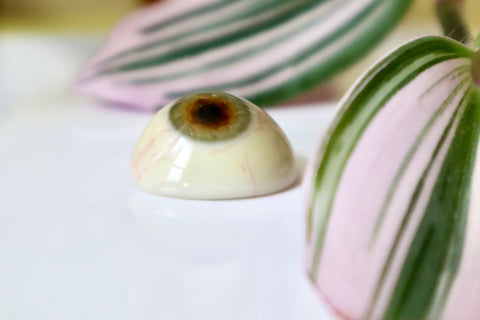Welcome to another 'Blog Post Monday'!
This week I'm going to be talking about one of my more gruesome recent finds. As a dealer, I've owned a set of silver teeth, what I thought was a prosthetic sterling silver finger tip and now... a prosthetic glass eye...! Yes, an eye... Excuse the pun, but I have had an eye on finding an antique glass eye for some time now, don't ask me why...
Anyway, the long and the short of it is that I found one in an antiques centre in Sheffield recently and with a fascination for the weird, the wonderful and the grotesque, I thought I'd dedicate this week's blog post to this little glass eye.
So, as always, get that kettle on, maybe put lunch on hold for a while and join me as we delve into the fascinating world of antique eye prosthesis...

The first evidence of human eye prostheses was discovered in Iran. The remains of a woman, dating back to 2900 BCE, was uncovered and would you believe it, she was sporting a prosthetic eye on the outside of her eye socket (pictured below). Made of clay, with a thin layer of gold covering it, the prosthesis had small holes drilled through it with gold thread fed through to hold it in place. It is believed that this woman was a priestess and that she may have used this eye to make people believe she had magical powers.

However, the first prosthetic eye worn inside the actual eye socket was reportedly made entirely of gold with coloured enamel decoration. Then, in the late 16th Century the Venetians started to create prosthetic eyes with glass. These were very fragile and uncomfortable for the wearer. The Venetians methodology for making these prostheses was very much hidden and protected until the Parisians took over. Then, in the mid-19th Century, glass-blowing techniques became more advanced and this shifted the hub of prosthetic eye manufacturing to Germany.

But with the commencement of World War II in 1939, glass was no longer available from Germany for the production of eye prostheses and, as a result, the United States government commissioned American companies to develop other techniques for making them and with that, the acrylic plastic eye was created. It subsequently became a superior alternative to the glass eye, being both transparent and shatter resistant, and a far more comfortable option than the glass eyes previously available. Today, most prosthetic eyes continue to be made out of acrylic, albeit of a higher medical grade.

The procedure for removing the natural eye is known as an enucleation, while the procedure to remove the contents of a natural eye is known as evisceration. Both of these procedures require a prosthetic restoration in the form of a prosthetic eye. The actual fitting of the prosthetic eye begins with an impression mould being taken to ensure the prosthesis has the correct look and ultimate comfort and movement.

The example that I found is from circa 1900 and the detail is quite incredible. More like a piece of beautiful glass art than medical prosthesis. I think this one likely belonged to an older male or female, as there's an ever so slight yellow tint to the white of the eye, something that happens to natural eyes as we go through the ageing process.

If you're as odd as me and have a fascination with antique curiosities, you'll be pleased to hear that this prosthetic glass eye is currently available to buy here.

Well, that's it for this week folks. I hope you've enjoyed this little insight into the world of antique eye prostheses. As always, let me know what you think in the comments section below.
Remember, if you enjoy my posts, please show your support by subscribing to my 'Source Social' membership, which you can do via the 'Home' page. It's free and gives you a weekly blog post and a fortnightly YouTube video delivered directly to your inbox, as well as exclusive discounts and first dibs on new items before they are added to our website.
And, speaking of my YouTube channel, if you're into antiques and haven't seen any of my videos yet, you can find them HERE. Head on over and subscribe to that too for your dose of finds, fairs, stories and reviews.
So, until next week, stay safe, keep buying those antiques and keep spreading that Source Vintage love!
Cheerio!
Stephen
Owner Source Vintage
Shop from Source Vintage here

Hello, I bought a prosthetic eye many many years ago. I was told it was a child’s eye. I realize it does not have any serial numbers, but does have a tiny little silver star embedded in the glass that can be seen from the inside. Any ideas?